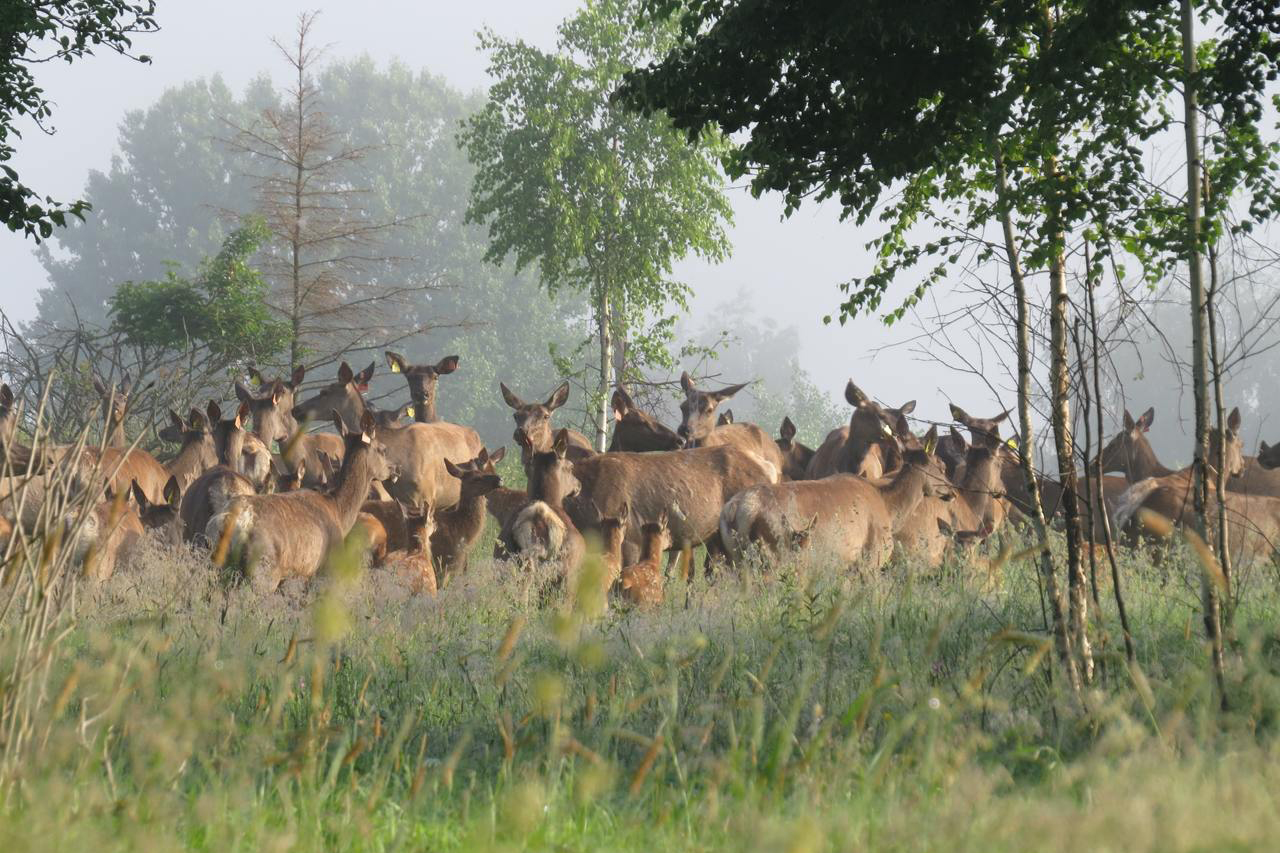Acoustic Battles for the Harem: How the Calls of Siberian Wapiti Reveal Their Status and Individuality
Researchers at HSE University, Lomonosov Moscow State University, and the A.N. Severtsov Institute of Ecology and Evolution of the Russian Academy of Sciences have studied the distinctive vocalisations of Siberian wapiti (Cervus canadensis sibiricus) stags during the peak of the mating season, when males produce rutting calls (bugles) to attract females (hinds) and deter rivals. The scientists have discovered how the acoustic parameters of these rutting calls reflect the stag's status—whether he currently holds a harem or is still attempting to acquire one—as well as his individual characteristics. The study has been published in Journal of Zoology.
Rutting calls are a vital component of intra-species interactions in Siberian wapiti, enabling stags to attract female hinds (sometimes entire groups) and intimidate rival males. These calls are integral to the mating season. In the wild, competition for keeping a harem (a group of females) is intense, prompting male ungulates to develop sophisticated strategies that combine physical displays and vocal demonstrations of strength. Acoustic displays are highly effective because they carry over long distances and remain reliable even in low-visibility conditions, such as at night, when deer engage in most of their interactions. Rutting calls enable females to assess a male's status and quality from a distance, while also signalling to rivals whether it is worth challenging him in a fight.

The study findings suggest that rutting calls act as a kind of 'passport,' reflecting the stag's harem-holding status. Compared to peripheral stags that remain outside a harem, harem holders produce shorter rutting calls with a higher minimum fundamental frequency.
The fundamental frequency of sound is a parameter that is subjectively perceived as the pitch of a voice and includes various measurements, such as the minimum, maximum, initial, and final fundamental frequencies. Moreover, even in a single stag, a change in status leads to alterations in the parameters of his rutting calls: when he acquires a harem, the initial and maximum fundamental frequencies of his calls decrease, while the minimum fundamental frequency increases, and the calls become shorter.

Although rutting calls can reflect a male's status and change as it evolves, their individual acoustic parameters typically remain consistent. It was previously believed that each stag has unique acoustic characteristics, a kind of vocal signature, allowing it to be distinguished from other stags. This presumed vocal individualisation is still used in nature reserves to monitor the number of stags by ear. In this method, a trained observer, stationed at a specific point, identifies the number of male deer nearby based on the differences in their voices.
According to Olga Sibiryakova, Associate Professor at the HSE Faculty of Biology and Biotechnology and co-author of the study, although individuality is encoded in rutting calls, it does not always manifest clearly enough: zoologists were able to correctly identify the individual stags in 53.2% of calls, which exceeds random chance but indicates that it is not always possible to identify a specific animal. It is noteworthy that discriminant analysis correctly classified 78.9% of bugles according to the stag's status.
'The vocalisations can convey information not only about the individual caller but also about his status, and status information is conveyed much more clearly in the sounds than individuality, which suggests that transmitting status information to others is of greater importance during the mating period,' the researcher notes.
The study findings can be applied to managing deer herds in natural environments, tracking these animals for conservation and hunting purposes, and developing non-invasive methods for studying ungulates. The use of non-invasive monitoring methods can facilitate the work of zoologists and ecologists by allowing them to track the status and behaviour of deer in various conditions without disrupting their natural habitat.
See also:
How Colour Affects Pricing: Why Art Collectors Pay More for Blue
Economists from HSE University, St Petersburg State University, and the University of Florida have found which colours in abstract paintings increase their market value. An analysis of thousands of canvases sold at auctions revealed that buyers place a higher value on blue and favour bright, saturated palettes, while showing less appreciation for traditional colour schemes. The article has been published in Information Systems Frontiers.
New Method for Describing Graphene Simplifies Analysis of Nanomaterials
An international team, including scientists from HSE University, has proposed a new mathematical method to analyse the structure of graphene. The scientists demonstrated that the characteristics of a graphene lattice can be represented using a three-step random walk model of a particle. This approach allows the lattice to be described more quickly and without cumbersome calculations. The study has been published in Journal of Physics A: Mathematical and Theoretical.
Scientists Have Modelled Supercapacitor Operation at Molecular and Ionic Level
HSE scientists used supercomputer simulations to study the behaviour of ions and water molecules inside the nanopores of a supercapacitor. The results showed that even a very small amount of water alters the charge distribution inside the nanopores and influences the device’s energy storage capacity. This approach makes it possible to predict how supercapacitors behave under different electrolyte compositions and humidity conditions. The paper has been published in Electrochimica Acta. The study was supported by a grant from the Russian Science Foundation (RSF).
Designing an Accurate Reading Skills Test: Why Parallel Texts are Important in Dyslexia Diagnosis
Researchers from the HSE Centre for Language and Brain have developed a tool for accurately assessing reading skills in adults with reading impairments. It can be used, for instance, before and after sessions with a language therapist. The tool includes two texts that differ in content but are equal in complexity: participants were observed to read them at the same speed, make a similar number of errors, and understand the content to the same degree. Such parallel texts will enable more accurate diagnosis of dyslexia and better monitoring of the effectiveness of interventions aimed at addressing it. The paper has been published in Educational Studies.
Internal Clock: How Heart Rate and Emotions Shape Our Perception of Time
Our perception of time depends on heart rate—this is the conclusion reached by neuroscientists at HSE University. In their experiment, volunteers watched short videos designed to evoke specific emotions and estimated each video's duration, while researchers recorded their heart activity using ECG. The study found that the slower a participant's heart rate, the shorter they perceived the video to be—especially when watching unpleasant content. The study has been published in Frontiers in Psychology.
Scientists Identify Personality Traits That Help Schoolchildren Succeed Academically
Economists from HSE University and the Southern Federal University have found that personality traits such as conscientiousness and open-mindedness help schoolchildren improve their academic performance. The study, conducted across seven countries, was the first large-scale international analysis of the impact of character traits on the academic achievement of 10 and 15-year-olds. The findings have been published in the International Journal of Educational Research.
HSE Scientists Reveal How Disrupted Brain Connectivity Affects Cognitive and Social Behaviour in Children with Autism
An international team of scientists, including researchers from the HSE Centre for Language and Brain, has for the first time studied the connectivity between the brain's sensorimotor and cognitive control networks in children with autism. Using fMRI data, the researchers found that connections within the cognitive control network (responsible for attention and inhibitory control) are weakened, while connections between this network and the sensorimotor network (responsible for movement and sensory processing) are, by contrast, excessively strong. These features manifest as difficulties in social interaction and behavioural regulation in children. The study has been published in Brain Imaging and Behavior.
Similar Comprehension, Different Reading: How Native Language Affects Reading in English as a Second Language
Researchers from the MECO international project, including experts from the HSE Centre for Language and Brain, have developed a tool for analysing data on English text reading by native speakers of more than 19 languages. In a large-scale experiment involving over 1,200 people, researchers recorded participants’ eye movements as they silently read the same English texts and then assessed their level of comprehension. The results showed that even when comprehension levels were the same, the reading process—such as gaze fixations, rereading, and word skipping—varied depending on the reader's native language and their English proficiency. The study has been published in Studies in Second Language Acquisition.
Mortgage and Demography: HSE Scientists Reveal How Mortgage Debt Shapes Family Priorities
Having a mortgage increases the likelihood that a Russian family will plan to have a child within the next three years by 39 percentage points. This is the conclusion of a study by Prof. Elena Vakulenko and doctoral student Rufina Evgrafova from the HSE Faculty of Economic Sciences. The authors emphasise that this effect is most pronounced among women, people under 36, and those without children. The study findings have been published in Voprosy Ekonomiki.
Scientists Discover How Correlated Disorder Boosts Superconductivity
Superconductivity is a unique state of matter in which electric current flows without any energy loss. In materials with defects, it typically emerges at very low temperatures and develops in several stages. An international team of scientists, including physicists from HSE MIEM, has demonstrated that when defects within a material are arranged in a specific pattern rather than randomly, superconductivity can occur at a higher temperature and extend throughout the entire material. This discovery could help develop superconductors that operate without the need for extreme cooling. The study has been published in Physical Review B.



